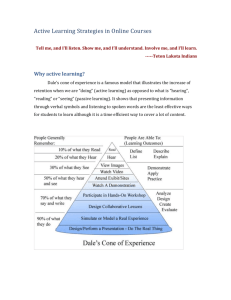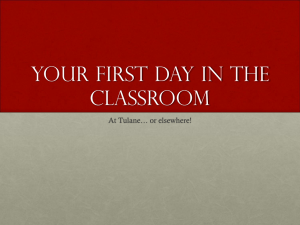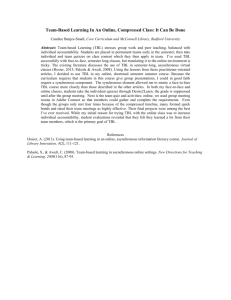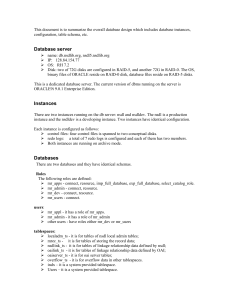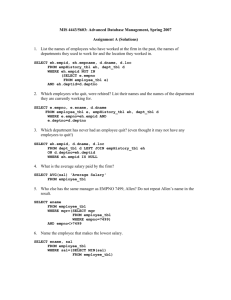TUSM 2014 Strategic Plan
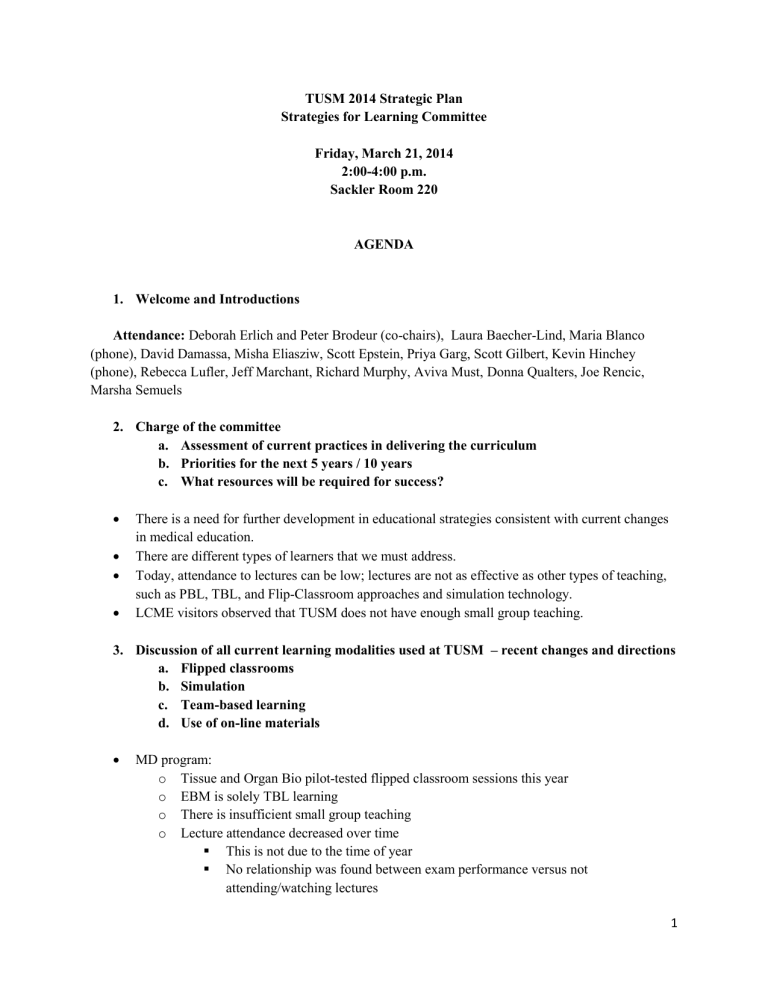
TUSM 2014 Strategic Plan
Strategies for Learning Committee
Friday, March 21, 2014
2:00-4:00 p.m.
Sackler Room 220
AGENDA
1.
Welcome and Introductions
Attendance: Deborah Erlich and Peter Brodeur (co-chairs), Laura Baecher-Lind, Maria Blanco
(phone), David Damassa, Misha Eliasziw, Scott Epstein, Priya Garg, Scott Gilbert, Kevin Hinchey
(phone), Rebecca Lufler, Jeff Marchant, Richard Murphy, Aviva Must, Donna Qualters, Joe Rencic,
Marsha Semuels
2.
Charge of the committee a.
Assessment of current practices in delivering the curriculum b.
Priorities for the next 5 years / 10 years c.
What resources will be required for success?
There is a need for further development in educational strategies consistent with current changes in medical education.
There are different types of learners that we must address.
Today, attendance to lectures can be low; lectures are not as effective as other types of teaching, such as PBL, TBL, and Flip-Classroom approaches and simulation technology.
LCME visitors observed that TUSM does not have enough small group teaching.
3.
Discussion of all current learning modalities used at TUSM – recent changes and directions a.
Flipped classrooms b.
Simulation c.
Team-based learning d.
Use of on-line materials
MD program: o Tissue and Organ Bio pilot-tested flipped classroom sessions this year o EBM is solely TBL learning o There is insufficient small group teaching o Lecture attendance decreased over time
This is not due to the time of year
No relationship was found between exam performance versus not attending/watching lectures
1
There is a core group of students that attend lectures
Significant number neither attend lecture nor watch online
MBS Program o Courses are like MD program, and share some classes with MD courses
MPH/MS program: o Keep classes small – anywhere from 15 to 20 students per class o Utilize a mixture of lectures, small groups and synthesis integration; high touch o Most classes provide students a participation grade; attendance requirements are up to course directors
PA program: o 30 to 50 students per class o Students are integrated into cohorts o Mandate attendance because it is a fast-tracked, short program o Offer traditional classes and have experimented with flipped classroom o Lectures are interactive, they are not recorded but allow audio capture, and lectures can be customized
Goal for programs: for students to learn, not for students to come to lecture o If lectures are engaging, they can work and be well received
Flipped Classroom Observations: o Bio-Statistics (MPH - Misha Eliasziw):
Moved all lectures online
Found that students would not participate in a lecture setting
Classroom meetings – professor now has more quality time for the students
Students go to class every second week
Group work, small discussions, group quiz o Works better with smaller groups – i.e. 35 students per group o Provide quiz or questions at the beginning of class
Give students 2 minutes to discuss student would explain best answer to class
professor would discuss for first hour of class o Encourage to ask questions o Very interactive o Professors can be more specific on how they can prepare for each group lecture o No grading for small groups o Limit the amount of prep time for each class o If different lecturers – standardize the teaching so every student’s experience is the same o Make questions as clinically-relevant as possible o Add grading aspect (1%) for participation or for completing a quiz
TBL o For clerkships:
Works when teams are sustained and individuals continue to work together
2 quizzes every 6 weeks
Case-based
OB/GYN Clerkship student reviews: more engaging, retain more information
2
o Challenge: how do you integrate TBL throughout third and fourth years? o Integration: talk amongst clerkship directors to integrate what each is learning across their individual clerkship program o Hematology/Oncology:
Split class in 2 groups, table of 8’s
There is no formal assessment
There are no quizzes
There is growing praise o EBM:
Lecture hall with 160 students
Individual quizzes and group quiz
Chaotic
Students grade participation of individuals in their group
Used Twitter o Classic TBL:
Individual quiz with multiple choice questions
Re-take quiz with group
Rate participation of each other – do not grade yourself o May need a technology that is available in a standardized format (i.e. on iPhone, webbased poll) to see which students are struggling
TED talk from founder of Coursera Stanford: http://www.ted.com/talks/daphne_koller_what_we_re_learning_from_online_education o Scaleable ideas – use the skills to deal with constraints o Smart phone enabled o At Tufts – Echo360 – instant feedback and more interactive for lectures o Virtual integration
Syllabi o Get rid of paper-based syllabi – use iPad? What if everyone had same technology o A resource issue interferes to do so
Strategy for choosing a technology for a course o Technology needs to match the learning goals o Find new ways to engage students with material for learning o Teaching drives the technology, technology doesn’t drive the teaching
MD program: o Would like to see more emphasis on problem-solving and critical thinking, and less emphasis on memorization
Assist students in preparing for boards
Reduce time in class
Reduce questions on exams
Assess what we want students to know
3
How to get more small-groups, more interaction
How to train faculty and how to get the resources to teach and for faculty to learn
How to continue threads in all 4 years? Capstone course in 4 th year? Use technology to do short reviews? Do this in 3 rd year, e.g., Repro Anatomy review before OB-GYN?
Prioritize what we need to do o Assessment o Test-enhanced learning – read for 20 minutes, then test it o Applied learning – read for 5 minutes, then apply it
The more we test, the better they will do
Resources – Space for teaching and learning o Current space may not provide adequate flexibility for need modalities
Faculty Devlepment – see who is doing TBL and have them teach other faculty
4 th year students in MedEd elective to help?
Different MCQ – higher order on Bloom’s?
Partner with publishers?
Use Catalytics – independent of device (no need for iClicker) or Poll Everywhere?
Formative assessment: higher learning
Move each core course online in next two years
Timeline for changes – take 3 to 5 years to change
Boards need increase significance o Make all exam questions board-type questions – could be challenging for first year
Barriers: additional classroom space, study rooms with white boards and Wi-Fi, possible technology (i.e. iPads), additional time to grade exams, resources to help make syllabi non-paper
4.
Next steps?
Priorities
Assessment
Resources
What would the approach be?
How do we put what we want to do into practice?
4


